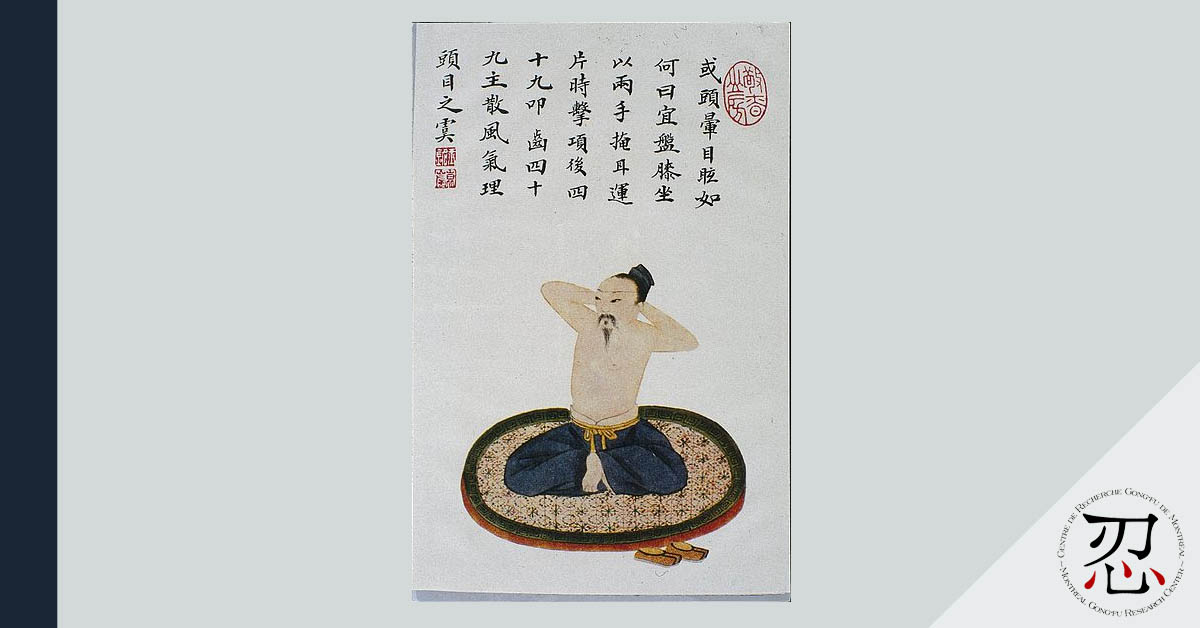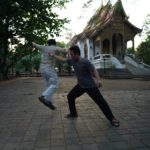
Ancient Chinese exercise for neck and back pain now used by physiotherapists
Illustration: “Technique for curing dizziness” (xuanyun), a 19th century recreation of the Daoyin Tu (Diagrams of Therapeutic Movement) from approximately 200 BC. Illustration by Kun Lan, dated 1875.
By Dan G. Reid, tuina massage therapist
Though lifestyles have changed significantly over the past several thousand years, the human body and its pains are nothing new. Whether we’re swinging sabers or tennis rackets, spraining an ankle on a battlefield or on a soccer field, the medical traditions of ancient China are still highly relevant. So when reading a 10th century Chinese medical text on prescribed exercises for physical ailments, it comes with a laugh of “but of course the longest-running medical tradition in the world thought of this first!” when I find an exercise now referred to by physiotherapists as the McKenzie Technique and “watching tennis in the sky.” These techniques, now as in ancient China, are used to relieve neck and back pain by lengthening the spine. Physiotherapists may also prescribe part of these exercises to release a pinched nerve in the neck that may be causing pain and numbness in the arms and hands, and to reduce forward-neck posture—so often the source of back and neck pain.
Now, before I describe the technique, please note that this article is only for educational purposes, and is not meant to offer prescription or diagnosis for any ailment. If you have pain or suffer other physical dysfunctions, please see a qualified therapist before trying this exercise as it may not be right for you at this time, if not outright harmful. If you decide on your own to try this technique, please stop if it causes you anything but relief. Attempting this exercise will be entirely at your own risk.
The translation below is from the Treatise on Origins and Symptoms of Medical Disorders (Zhubing yuanhou lun諸病源候論), which was compiled in 1027 AD and contains manuscripts dating back to at least 752 AD. It appears on page 430 of Dolly Yang’s 2018 PhD dissertation, Prescribing ‘Guiding and Pulling’: The institutionalisation of therapeutic exercise in Sui China (581–618 CE) which will be available next year in her illustrated book published by Purple Cloud Institute.
又云︰凡人常覺脊強,不問時節,縮咽髆內,仰面努搏井向上也。頭左右兩向挪之,左右三七,一住,待血行氣動定,然始更用,初緩後急,不得先急後緩。
Again, it says: Whenever there is stiffness in your spine, regardless of the seasons, tuck your throat between the shoulder blades. Raise your head and try to make the boujing points [inner corner of the eyes] facing upwards. Then move your head between left and right, both directions, left and right three times seven times, stay for a while. Wait until the circulating blood and the moving qi settled; then you continue to practice it again. Start slowly and become faster at the end. You must not get fast in the beginning and slow at the end.
As is often the case with ancient texts, these instructions could benefit from further commentary. How exactly does one tuck their throat between their shoulder blades? Maybe the human body has changed more than I thought? No. You can perform this maneuver by sitting or standing with a straight posture and following a few simple steps:
Step 1
For some, it will help to begin by supporting your neck, though these exercises can also be performed without this additional support. To support your neck: put your hands next to your neck so that your fingers are parallel to your spine and pointing down toward your back, then pull your trapezius muscles forward.
Step 2
Next, just as in the McKenzie technique, simply sit or stand in a straight posture and look straight ahead so that your chin remains horizontal and then bring your head back somewhat like a reverse chicken peck, creating a “double chin” effect.
Step 3
With your head in the reverse chicken peck position, angle your chin down to lengthen the spine and try to “tuck your throat between the shoulder blades.” Hold for about 10 seconds and then return your head to normal position. Repeat as desired.
If you spend a lot of time looking down at a cell phone, computer, or potential spies from a watchtower, this exercise is excellent to counter that dispirited forward head posture that can send all the wrong signals to your mind about your emotional state, not to mention the immense weight that forward head posture puts on your neck and back. For every inch that your earlobes move in front of your shoulders, an extra ten pounds of weight pulls on your neck (cervical) spine, causing tension in the muscles of your neck and back. So maintaining a balanced head posture can actually release tension all the way through your core. If you find you’re habitually looking down, the above stretch can help to correct your head posture and train your body to feel comfortable with a balanced head posture.
Some clients may need several days or more of the first three steps before they can perform them without restriction or pain, but if all goes well with tucking their throat between their shoulder blades, the client can move on to the next exercise. The next exercise is performed by first following steps 1 to 3, above, and then rolling the head back until the inner corners of the eye point to the sky (again, if this can be done pain-free). Return the head to normal position and repeat these four steps a few more times.
Now for the final exercise, which I have seen more recently described as “watching tennis in the sky.” If the client can point the inner corner of their eyes to the sky, they can slowly begin this fifth step. From the fourth position—looking at the sky—slowly turn the chin while looking to the left and right a few times each as though watching a slow-motion tennis game in the sky. Return to normal position and then repeat all of the above a couple more times. As the treatise above describes it,
Then move your head between left and right, both directions, left and right three times seven times, stay for a while. Wait until the circulating blood and the moving qi settled; then you continue to practice it again. Start slowly and become faster at the end. You must not get fast in the beginning and slow at the end.
A little bonus exercise I’ll add here: For an added stretch to relax the spine, relax your lower spine and let it hang down while your legs swing freely when you walk. Notice that internal feeling of space and freedom when you feel loose and free physically/externally. All the more reason to practice good postural hygiene and exercises like Wangji Wu’s Xingyi Neigong (see schedule). For further assistance, a good tuina massage therapist can help to bring the body back to its ideal alignment by rebalancing the musculoskeletal system and removing unnecessary tension.



Corina Herrera
March 3, 2023 at 3:32 amI’m going to try these exercises for my neck pain, thank you